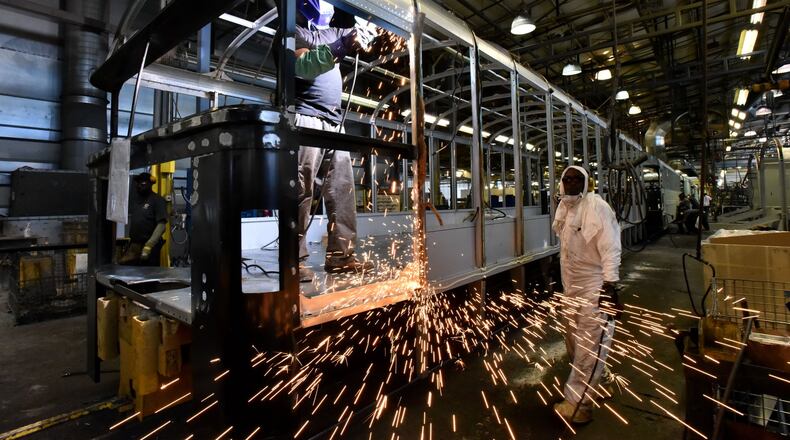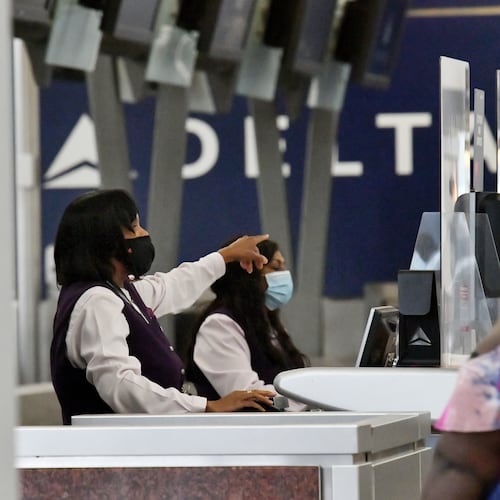FORT VALLEY, Ga. — As a welder’s sparks flew, a cage of silver ribs grew around the worker, as if Jonah’s whale had surfaced in Blue Bird Corp.’s factory and swallowed him up.
Down the 89-year-old company’s assembly line, dozens of metal skeletons materialized piece by piece, turning into the familiar shapes of school buses. Workers in the 1 million square-foot factory bolted together frames, hooked up engines and transmissions, and painted yellow school bus bodies with each district’s name. Almost all the work was done by hand.
Blue Bird, the largest employer in this town of 9,800 people in the peach-and-pecan country of central Georgia, is thriving on the kind of labor-intensive manufacturing that President-elect Donald J. Trump has promised to keep from moving out of the United States.
He has promised to strong-arm Mexico and other countries into concessions on free trade pacts, and threatened to slap stiff tariffs on products imported by American companies that shifted work overseas.
Trump recently publicly shamed Carrier, a unit of United Technologies Corp., into keeping about 800 jobs at its Indianapolis factory that it had planned to move to Mexico.
In contrast, Blue Bird has no plans to move.
“I think we’ve shown here we are in central Georgia with an efficient work force,” said Phil Horlock, Blue Bird’s chief executive. “It’s really a pretty competitive business. We don’t want to go offshore.”
Blue Bird added a second shift this year at its Fort Valley plant for the first time in at least 20 years, said Horlock, boosting employment by 500, to 2,300 workers at its peak earlier this year.
Still, a closer look at Blue Bird and other manufacturers in Georgia shows why Trump may have a hard time restoring a manufacturing base that has shrunk dramatically over the last five decades. Many of the companies that remain have found specialized niches or strategies to stay here.
Blue Bird, for instance, essentially custom-makes buses for many of the 10,000 school districts across the nation, which have widely varying safety rules and standards and a preference for American-made buses.
“Made in America is really important to them,” said Horlock.
But if Trump makes good on his campaign promises to tear up international trade deals and negotiate new ones, he risks upsetting many Georgia manufacturers’ existing operations — including Blue Bird’s — if a blunder results in trade disputes or a recession.
“I think what he’s after is better deals,” said Jeff Humphreys, director of economic forecasting at the University of Georgia. But a trade war and recession “would be very tough on Georgia,” he said.
Many Georgia plants are U.S. units of overseas manufacturers that were set up here to serve the American market. Many factories, whether U.S. or internationally owned, also depend on parts and assemblies imported from factories in Mexico or elsewhere.
Blue Bird has a joint venture with a bus body builder in Mexico that has opened the door to export sales in Colombia, said Horlock, the company’s CEO.
“Mexico has been good to get us in other markets,” he said. Suppliers in China, Mexico, Canada and Vietnam supply about 15 percent of the parts in Blue Bird’s buses, he added.
At least for now, manufacturing jobs are on the rise in Georgia and the nation.
“To some extent, what [Trump] promised is already happening,” said Humphreys.
Georgia’s manufacturing employment has been growing for six years, he said, possibly reversing the decades-long slide that worsened during the Great Recession. Since the end of 2009, Georgia manufacturers have added back about 40 percent of the nearly 107,000 jobs they shed from 2005 to 2009.
Still, factory work now accounts for only about 8 percent of jobs in the U.S. and less than 9 percent in Georgia, down from a third of all jobs in 1950s and 1960s.
Millions lost their jobs as businesses sent work to countries with cheaper labor, or they lost out to overseas competitors. But many Americans also lost jobs due to technological advances — robots, software and other innovations — that have allowed companies to produce, ship and sell more goods with fewer workers.
Georgia and other states also have been raiding each other for manufacturing employers, luring companies with millions of dollars of tax breaks, training assistance and other assistance.
“Georgia has been very aggressive and very effective at courting manufacturers,” said Humphreys.
For instance, Jindal Films, a manufacturer of polypropylene materials for packaging and labels, moved its U.S. headquarters and research and development center late last year from Shawnee, Okla., to its LaGrange plant and expanded, adding 240 jobs.
Humphreys said Georgia’s manufacturers also have done comparatively well in recent years because they weren’t hurt by the downturn in the oil industry, and benefited from lower energy prices. Likewise, the state’s ports and other logistics infrastructure have attracted some manufacturers, he said.
Blue Bird, which is about 30 miles southwest of Macon in Peach County, has relied on a combination of mass customization, cost-cutting and low-cost rural labor to stay competitive.
About one in six of its factory-floor workers are seasonal. Their starting pay is $12 an hour, or $480 per week, about two-thirds of Peach County’s already low average pay of $740 a week. The state-wide average was $1,001.
Horlock said pay for most hourly workers is higher, ranging from $15 up to $24 for long-time skilled employees such as welders, mechanics, riveters and painters.
Flexible manufacturing and low costs
Those workers are at the core of Blue Bird’s mass customization strategy.
To meet school districts’ widely varying demands, the Fort Valley factory essentially custom-tailors its buses, hand-building them in thousands of different combinations of seating plans, engines, fuel types and sizes, from 23 feet to 40 feet long.
“There is no automation. I came from where there are lots of robots,” said John McKowen, a former Ford Motor Co. employee who now heads Blue Bird’s manufacturing operations. “It’s like going back in time. When I first got here, it was like ‘What, I’m back in the 60s?’ “
The one obvious piece of modern technology in the plant are numerous 22-inch computer screens along the assembly line. Since each bus is different, workers consult the screens to see what parts or tasks each bus requires.
At first, McKowan looked for repetitive assembly steps that could be automated, but quickly realized that automation wasn’t going to work, and that Blue Bird’s mass customization approach to manufacturing was one of its strengths.
School districts “want what they want,” he said. Blue Bird’ goal is “how flexible can we be?”
But that approach wasn’t enough to protect the company during the Great Recession.
When the real estate crash ravaged school district’s revenues from property taxes, orders for school buses plunged and sent Blue Bird into the ditch.
When Horlock joined Blue Bird in 2010 as its chief financial officer, the company had two factories in Fort Valley and in LaFayette, Ga., near Chattanooga, but not enough work for either plant.
“We were working three days a week. We were sending people home,” said Horlock.
When he was named president later that year, Blue Bird closed its 250-employee LaFayette plant and moved its production equipment to Fort Valley. About 50 employees followed.
The cost-cutting “certainly reduced our break-even point,” said Horlock, allowing the company to survive on lower revenues. Once the bus industry started to recover in 2012, lower costs allowed Blue Bird to invest in developing new types of buses using propane, compressed natural gas, gasoline and smaller, more efficient diesel engines.
Horlock said the alternative fuel buses can save schools thousands of dollars a year compared to traditional diesel-engine buses.
The moves and the reviving economy helped boost Blue Bird’s revenues by 70 percent since 2010, to $930 million. Likewise, its market share rose from 23 percent to 31 percent in the same period, according to Horlock.
As annual production soared from 6,000 buses in 2010 to 10,600 this year, so did hiring.
The company hired 500 workers this year and added a second shift, boosting employment to 2,300 during its peak production months in the spring and summer. The labor force has since dropped to 2,000 as it shed seasonal employees.
In 2010, the company had about 1,500 workers at its two plants.
Zerah Bond, customer service manager at Harveys Supermarket, just down the road from the plant, said Blue Bird’s growth gave a noticeable boost to the store and the town.
“We love Blue Bird. We really do. They put a lot of money into the community,” said Bond. She said her son-in-law left his father’s home restoration business to work at the plant.
“Better hours, better pay, better benefits,” she said.
She said the grocery store’s deli gets a lot of traffic during the factory’s lunch hours, and another big bump on weekly paydays.
“We cash a lot of their paychecks every Thursday,” she said. “We call them Blue Bird days.”
- ON TWITTER: @BlueBirdBuses
About the Author
Keep Reading
The Latest
Featured



